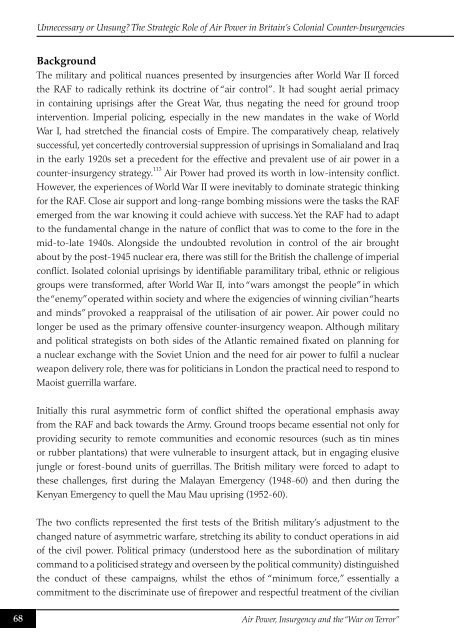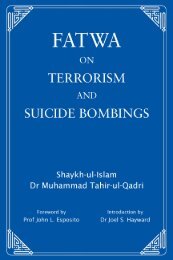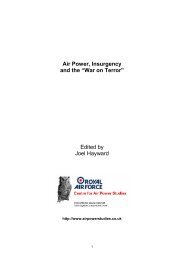Air Power, Insurgency and the âWar on Terrorâ - Prof. Joel Hayward's ...
Air Power, Insurgency and the âWar on Terrorâ - Prof. Joel Hayward's ...
Air Power, Insurgency and the âWar on Terrorâ - Prof. Joel Hayward's ...
You also want an ePaper? Increase the reach of your titles
YUMPU automatically turns print PDFs into web optimized ePapers that Google loves.
Unnecessary or Unsung? The Strategic Role of <str<strong>on</strong>g>Air</str<strong>on</strong>g> <str<strong>on</strong>g>Power</str<strong>on</strong>g> in Britain’s Col<strong>on</strong>ial Counter-Insurgencies<br />
Background<br />
The military <str<strong>on</strong>g>and</str<strong>on</strong>g> political nuances presented by insurgencies after World War II forced<br />
<str<strong>on</strong>g>the</str<strong>on</strong>g> RAF to radically rethink its doctrine of “air c<strong>on</strong>trol”. It had sought aerial primacy<br />
in c<strong>on</strong>taining uprisings after <str<strong>on</strong>g>the</str<strong>on</strong>g> Great War, thus negating <str<strong>on</strong>g>the</str<strong>on</strong>g> need for ground troop<br />
interventi<strong>on</strong>. Imperial policing, especially in <str<strong>on</strong>g>the</str<strong>on</strong>g> new m<str<strong>on</strong>g>and</str<strong>on</strong>g>ates in <str<strong>on</strong>g>the</str<strong>on</strong>g> wake of World<br />
War I, had stretched <str<strong>on</strong>g>the</str<strong>on</strong>g> financial costs of Empire. The comparatively cheap, relatively<br />
successful, yet c<strong>on</strong>certedly c<strong>on</strong>troversial suppressi<strong>on</strong> of uprisings in Somalial<str<strong>on</strong>g>and</str<strong>on</strong>g> <str<strong>on</strong>g>and</str<strong>on</strong>g> Iraq<br />
in <str<strong>on</strong>g>the</str<strong>on</strong>g> early 1920s set a precedent for <str<strong>on</strong>g>the</str<strong>on</strong>g> effective <str<strong>on</strong>g>and</str<strong>on</strong>g> prevalent use of air power in a<br />
counter-insurgency strategy. 113 <str<strong>on</strong>g>Air</str<strong>on</strong>g> <str<strong>on</strong>g>Power</str<strong>on</strong>g> had proved its worth in low-intensity c<strong>on</strong>flict.<br />
However, <str<strong>on</strong>g>the</str<strong>on</strong>g> experiences of World War II were inevitably to dominate strategic thinking<br />
for <str<strong>on</strong>g>the</str<strong>on</strong>g> RAF. Close air support <str<strong>on</strong>g>and</str<strong>on</strong>g> l<strong>on</strong>g-range bombing missi<strong>on</strong>s were <str<strong>on</strong>g>the</str<strong>on</strong>g> tasks <str<strong>on</strong>g>the</str<strong>on</strong>g> RAF<br />
emerged from <str<strong>on</strong>g>the</str<strong>on</strong>g> war knowing it could achieve with success. Yet <str<strong>on</strong>g>the</str<strong>on</strong>g> RAF had to adapt<br />
to <str<strong>on</strong>g>the</str<strong>on</strong>g> fundamental change in <str<strong>on</strong>g>the</str<strong>on</strong>g> nature of c<strong>on</strong>flict that was to come to <str<strong>on</strong>g>the</str<strong>on</strong>g> fore in <str<strong>on</strong>g>the</str<strong>on</strong>g><br />
mid-to-late 1940s. Al<strong>on</strong>gside <str<strong>on</strong>g>the</str<strong>on</strong>g> undoubted revoluti<strong>on</strong> in c<strong>on</strong>trol of <str<strong>on</strong>g>the</str<strong>on</strong>g> air brought<br />
about by <str<strong>on</strong>g>the</str<strong>on</strong>g> post-1945 nuclear era, <str<strong>on</strong>g>the</str<strong>on</strong>g>re was still for <str<strong>on</strong>g>the</str<strong>on</strong>g> British <str<strong>on</strong>g>the</str<strong>on</strong>g> challenge of imperial<br />
c<strong>on</strong>flict. Isolated col<strong>on</strong>ial uprisings by identifiable paramilitary tribal, ethnic or religious<br />
groups were transformed, after World War II, into “wars am<strong>on</strong>gst <str<strong>on</strong>g>the</str<strong>on</strong>g> people” in which<br />
<str<strong>on</strong>g>the</str<strong>on</strong>g> “enemy” operated within society <str<strong>on</strong>g>and</str<strong>on</strong>g> where <str<strong>on</strong>g>the</str<strong>on</strong>g> exigencies of winning civilian “hearts<br />
<str<strong>on</strong>g>and</str<strong>on</strong>g> minds” provoked a reappraisal of <str<strong>on</strong>g>the</str<strong>on</strong>g> utilisati<strong>on</strong> of air power. <str<strong>on</strong>g>Air</str<strong>on</strong>g> power could no<br />
l<strong>on</strong>ger be used as <str<strong>on</strong>g>the</str<strong>on</strong>g> primary offensive counter-insurgency weap<strong>on</strong>. Although military<br />
<str<strong>on</strong>g>and</str<strong>on</strong>g> political strategists <strong>on</strong> both sides of <str<strong>on</strong>g>the</str<strong>on</strong>g> Atlantic remained fixated <strong>on</strong> planning for<br />
a nuclear exchange with <str<strong>on</strong>g>the</str<strong>on</strong>g> Soviet Uni<strong>on</strong> <str<strong>on</strong>g>and</str<strong>on</strong>g> <str<strong>on</strong>g>the</str<strong>on</strong>g> need for air power to fulfil a nuclear<br />
weap<strong>on</strong> delivery role, <str<strong>on</strong>g>the</str<strong>on</strong>g>re was for politicians in L<strong>on</strong>d<strong>on</strong> <str<strong>on</strong>g>the</str<strong>on</strong>g> practical need to resp<strong>on</strong>d to<br />
Maoist guerrilla warfare.<br />
Initially this rural asymmetric form of c<strong>on</strong>flict shifted <str<strong>on</strong>g>the</str<strong>on</strong>g> operati<strong>on</strong>al emphasis away<br />
from <str<strong>on</strong>g>the</str<strong>on</strong>g> RAF <str<strong>on</strong>g>and</str<strong>on</strong>g> back towards <str<strong>on</strong>g>the</str<strong>on</strong>g> Army. Ground troops became essential not <strong>on</strong>ly for<br />
providing security to remote communities <str<strong>on</strong>g>and</str<strong>on</strong>g> ec<strong>on</strong>omic resources (such as tin mines<br />
or rubber plantati<strong>on</strong>s) that were vulnerable to insurgent attack, but in engaging elusive<br />
jungle or forest-bound units of guerrillas. The British military were forced to adapt to<br />
<str<strong>on</strong>g>the</str<strong>on</strong>g>se challenges, first during <str<strong>on</strong>g>the</str<strong>on</strong>g> Malayan Emergency (1948-60) <str<strong>on</strong>g>and</str<strong>on</strong>g> <str<strong>on</strong>g>the</str<strong>on</strong>g>n during <str<strong>on</strong>g>the</str<strong>on</strong>g><br />
Kenyan Emergency to quell <str<strong>on</strong>g>the</str<strong>on</strong>g> Mau Mau uprising (1952-60).<br />
The two c<strong>on</strong>flicts represented <str<strong>on</strong>g>the</str<strong>on</strong>g> first tests of <str<strong>on</strong>g>the</str<strong>on</strong>g> British military’s adjustment to <str<strong>on</strong>g>the</str<strong>on</strong>g><br />
changed nature of asymmetric warfare, stretching its ability to c<strong>on</strong>duct operati<strong>on</strong>s in aid<br />
of <str<strong>on</strong>g>the</str<strong>on</strong>g> civil power. Political primacy (understood here as <str<strong>on</strong>g>the</str<strong>on</strong>g> subordinati<strong>on</strong> of military<br />
comm<str<strong>on</strong>g>and</str<strong>on</strong>g> to a politicised strategy <str<strong>on</strong>g>and</str<strong>on</strong>g> overseen by <str<strong>on</strong>g>the</str<strong>on</strong>g> political community) distinguished<br />
<str<strong>on</strong>g>the</str<strong>on</strong>g> c<strong>on</strong>duct of <str<strong>on</strong>g>the</str<strong>on</strong>g>se campaigns, whilst <str<strong>on</strong>g>the</str<strong>on</strong>g> ethos of “minimum force,” essentially a<br />
commitment to <str<strong>on</strong>g>the</str<strong>on</strong>g> discriminate use of firepower <str<strong>on</strong>g>and</str<strong>on</strong>g> respectful treatment of <str<strong>on</strong>g>the</str<strong>on</strong>g> civilian<br />
68<br />
<str<strong>on</strong>g>Air</str<strong>on</strong>g> <str<strong>on</strong>g>Power</str<strong>on</strong>g>, <str<strong>on</strong>g>Insurgency</str<strong>on</strong>g> <str<strong>on</strong>g>and</str<strong>on</strong>g> <str<strong>on</strong>g>the</str<strong>on</strong>g> “War <strong>on</strong> Terror”





